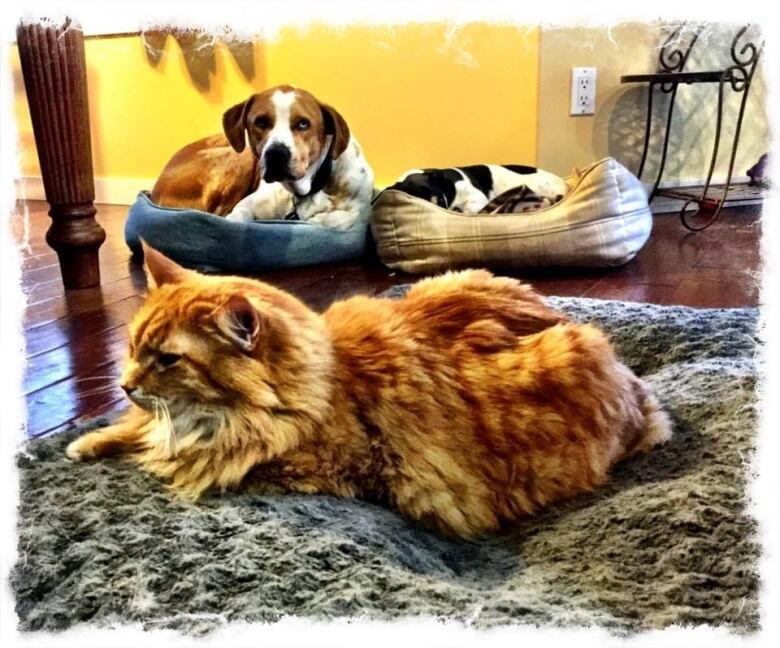In 2018, Crystal Maclean’s cat Ralph bolted from the Kamloops, B.C., apartment she was sharing with a friend. Recently, her sister-in-law saw a photo on an SPCA Facebook page. Now, Maclean, who lives in New Liskeard, Ont., is purring with delight.

In 2018, Crystal Maclean’s cat Ralph bolted from the Kamloops, B.C., apartment she was sharing with a friend.
“I put up posters, I called the SPCA, I walked the neighbourhoods,” Maclean said. “I connected with the postal carriers and still, no luck. Everything failed.”
Maclean gave up the search, assuming Ralph, a 10-year-old Maine Coon that typically wouldn’t venture far from the house, had met his demise by coyote.
“He used to come when I called him, but no luck,” Maclean said.
Maclean ended up moving overseas with her husband for a job posting.
In 2020, she returned home and settled in New Liskeard, Ont.
She said she even forgot about her lost cat, bringing new pets — cat and dog — into the home.
But in January 2022, something unexpected happened.
That is what most cat friends like about the animals — they’re still natural even when enjoying our living rooms.– Dennis Turner, Institute for Applied Ethology and Animal Psychology, Switzerland
Maclean received a photo from her sister-in-law back in Kamloops.
“[My sister-in-law] saw a picture of what she thought was Ralph on the Kamloops SPCA Facebook page,” Maclean said. “It was put up Jan. 25.
“So she sent me the picture and I thought, ‘Gee, that looks like Ralph.’ I mean, it’s been almost four years.”
Maclean contacted the Kamloops SPCA, exchanging pictures with the group. Eventually, the SPCA phoned her back.
“They said, ‘This is Ralph,'” Maclean said.
Although orange cats tend to share similar features, Ralph had a distinctive black spot at the bottom of his nose, which helped the SPCA identify him, she said.
When the SPCA confirmed it was her cat, Maclean said it elicited “big emotions.”
“I’ve had him since he was six weeks old and had him for close to 10 years before I lost him,” she said.
“He’s the best cat.”
Ralph is expected to arrive in Toronto by plane this week, and from there, onto his new home in New Liskeard.
So what happened to Ralph?
Curious about his whereabout the last four years, Maclean said she connected with the woman who brought Ralph into the SPCA.
“Her and her husband are retired and they live maybe a kilometre from where Ralph bolted,” she said. “He just showed up, maybe two and a half years ago,” Maclean said.
The woman fed Ralph, but with her husband’s serious allergic reactions to the long-haired cat, didn’t bring the visitor inside. After years of feeding the stray, she eventually brought it to the SPCA.

Despite living on his own and fending for himself, the pictures of Ralph show the cat has held up rather well, Maclean said.
“He’s a great big, long-haired Maine Coon cat, so his fur has become quite matted, and I think they’ve cut out some of the mats.
“He looks a little worse for wear, but he’s still going strong.”
Cat behaviour, explained
Dennis Turner is director of the Institute for Applied Ethology and Animal Psychology in Horgen, Switzerland.
Turner said although it isn’t surprising that a domestic cat would run away, they are still “instinctively effective hunters” that can survive if they’re let loose.
“If the cat was wandering about and happened on another household with cat-friendly people, they might have started to feed it, who knows, even with a preferred food — like fish or shrimps, and the cat decided to stay with them for so long,” Turner said in an email to CBC. “Perhaps prey items, especially rodents, were particularly abundant when the cat first left the household, making an outdoor life easier.”
Even with the relative comforts of home nearby, domestic cats are know to range up to 1,000 hectares, Turner said. But that doesn’t mean the wild life is an easy one.
“Cats are semi-wild creatures that choose to live with us if they receive warmth, affection, shelter and of course food. But all cats are capable of catching prey when discovered and if it is available in the area.”

Turner, author of The Domestic Cat. The biology of its behaviour, said cats typically choose the “easy way out” and stay with humans.
“We appreciate that, even though they might catch and eat an occasional mouse if allowed outdoors,” he said.
“They’ve only been domesticated for several thousand years and purposely bred, mostly affecting just their coat colour and qualities, only during several hundred years.
“That is what most cat friends like about the animals — they’re still natural even when enjoying our living rooms.”

